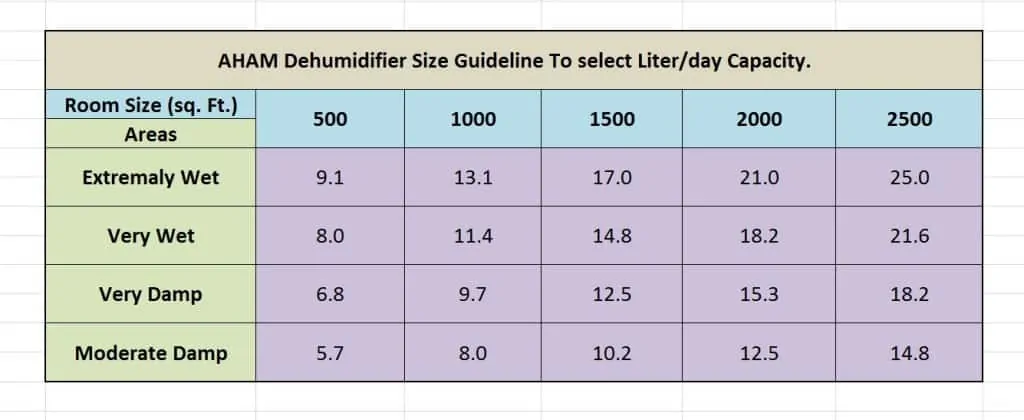Dehumidifier Calculation, dehumidifier capacity calculation, dehumidifier sizing, home dehumidifier
Home dehumidifier sizing calculation.
Dehumidifier sizing is always a big challenge for users. In particular. for home users, it is a confusing task. Once we decided to go for a new unit, then we always faced the question of capacity. Several dehumidifier capacity calculation charts are available online. But, one should know how to use it for proper dehumidifier calculation.
From this article, we will learn how to decide the capacity of a home dehumidifier.
Table of contents
Why is dehumidifier sizing important?
While selecting the dehumidifier, we need to make sure that capacity is enough. In other words, it should remove humidity, and at the same time, it should meet airflow needs. In other words, it should remove moisture with meeting airflow. If dehumidifier capacity calculation is less, then the unit will not reduce humidity. In contrast, if the size is large, later you will pay more for unit and power. Hence, proper dehumidifier sizing is a must.
Dehumidifier sizing units.
Extraction capacity generally mentioned in liters/day or pints/day. On the other hand, airflow in cubic meter per hour. It is nothing but the amount of water that dehumidifiers can extract from the air in one day. Moisture from the air will remove only when it passes through the dehumidifier. Thus, the airflow volume is an essential factor.
More airflow, more air will pass through the dehumidifier. And, the moisture level from the air will come down faster. Higher dehumidifier sizing means, high capacity of extraction and airflow.
Dehumidifier Sizing method.

As long as the dehumidifier for home concerned, AHAM has made the job very easy. AHAM stands for the Association of Home Appliance Manufacturers. Point to note, AHAM offered the easiest dehumidifier capacity calculation method. AHAM suggests dehumidifier sizing based on room size and humidity level in the room.
The capacity of the dehumidifier is proportional to the humidity level in the room and size of the room. Depending on the level of humidity and its symptoms, AHAM divided the area into four types.
Areas for dehumidifier capacity calculation.
As mentioned before, areas divided into the following four types.
1) Extra wet area: Areas with extra high humidity levels. Hence, the room has wet floors and high-load Conditions.
2) Very wet area: Areas with high humidity which tends to condensation. Thus, we can observe water drops formation or seepage on walls.
3) Very damp area: Common symptoms of these areas are, bad odor from the carpet, clothing, sofa, and spots on the walls.
4) Moderate damp Area: In such areas, you feel uncomfortable and with the smell. So, even humidity is high, but it is bearable.
Depending on room type and area, you can do dehumidifier sizing. Please follow the chart given below. For example, for a very damp room of 500 square feet, you need 6.8 liters/day capacity.

Airflow calculation for dehumidifiers.
CFM Airflow volume needed in the room decided with the area and humidity level in the place. The area of the room determines how much air should pass through the dehumidifier. And, the humidity level in the room determines how many times this air should pass through the unit in an hour. This term denoted as ACH or air changing per hour.
ACH is a crucial factor in dehumidifier sizing. To calculate air flow in CFM, we need to multiply the volume of the room to recommended ACH for that room. After that, divide multiplication by 60 to get CFM. Please note, the area should be in square feet. To get the volume of the room, multiply the area of the room with its height.
ACH for a dehumidifier size.
Recommended ACH from different areas as follows:
1) For Extra wet area: These are areas where humidity level in the range of 90% to 100% RH. And, recommended ACH is 6.
2) For Very wet area: Generally, these are areas that have a moisture level of 80% to 90% RH. Thus, for dehumidifier sizing, the suggested ACH is 5.
3) For Very damp area: The notable humidity in these areas is 70% to 80% RH. Hence, the proposed ACH is 4.
4) For Damp area: These are areas having a humidity of 60% to 70% RH. Therefore, the ACH of 3 is suitable for it.
We will continue the same example. Hence, a very damp room of 500 square feet and a height of 9 feet, needs airflow of 300 CFM.

